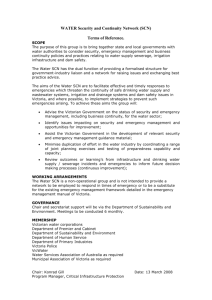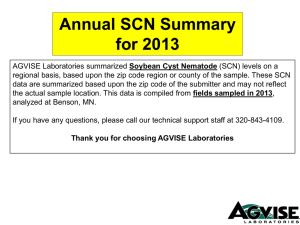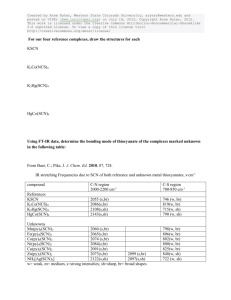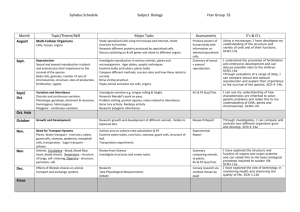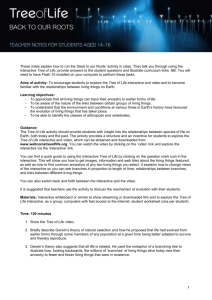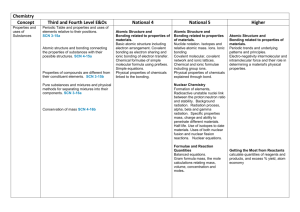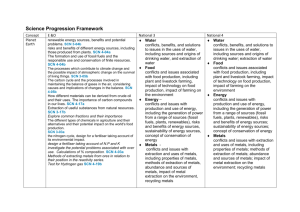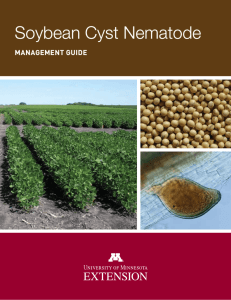7. Why are SCN numbers variable? 8.What are HG Types?
advertisement
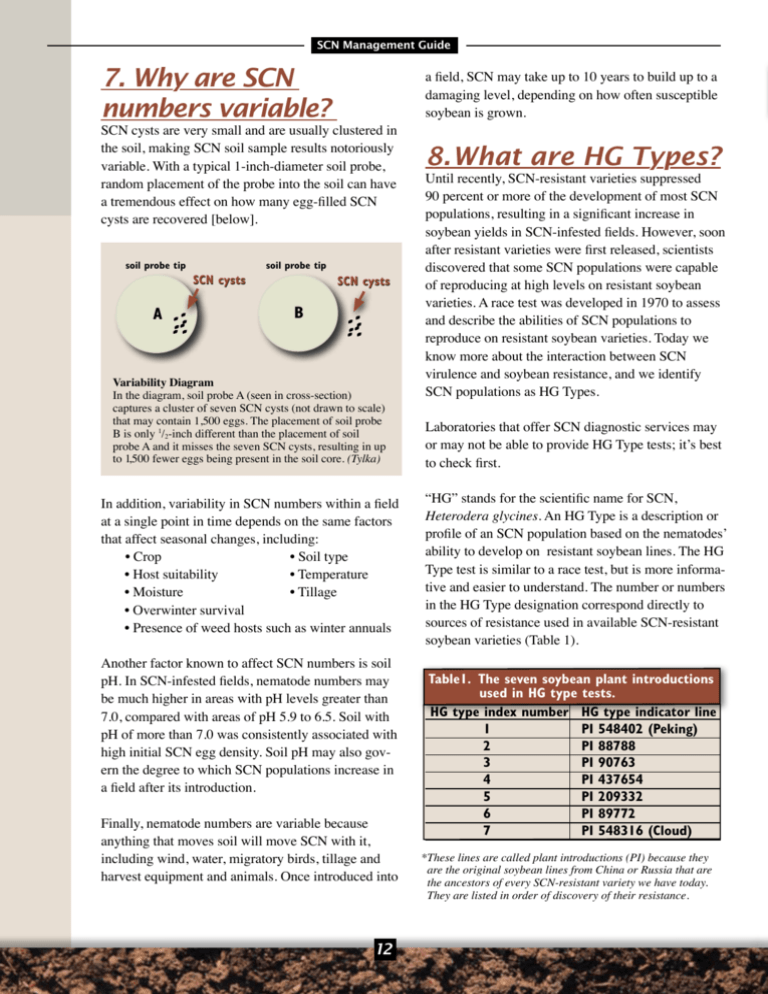
SCN Management Guide 7. Why are SCN numbers variable? SCN cysts are very small and are usually clustered in the soil, making SCN soil sample results notoriously variable. With a typical 1-inch-diameter soil probe, random placement of the probe into the soil can have a tremendous effect on how many egg-filled SCN cysts are recovered [below]. soil probe tip soil probe tip SCN cysts A SCN cysts B Variability Diagram In the diagram, soil probe A (seen in cross-section) captures a cluster of seven SCN cysts (not drawn to scale) that may contain 1,500 eggs. The placement of soil probe B is only 1/2-inch different than the placement of soil probe A and it misses the seven SCN cysts, resulting in up to 1,500 fewer eggs being present in the soil core. (Tylka) In addition, variability in SCN numbers within a field at a single point in time depends on the same factors that affect seasonal changes, including: • Crop • Soil type • Host suitability • Temperature • Moisture • Tillage • Overwinter survival • Presence of weed hosts such as winter annuals Another factor known to affect SCN numbers is soil pH. In SCN-infested fields, nematode numbers may be much higher in areas with pH levels greater than 7.0, compared with areas of pH 5.9 to 6.5. Soil with pH of more than 7.0 was consistently associated with high initial SCN egg density. Soil pH may also govern the degree to which SCN populations increase in a field after its introduction. Finally, nematode numbers are variable because anything that moves soil will move SCN with it, including wind, water, migratory birds, tillage and harvest equipment and animals. Once introduced into 12 a field, SCN may take up to 10 years to build up to a damaging level, depending on how often susceptible soybean is grown. 8.What are HG Types? Until recently, SCN-resistant varieties suppressed 90 percent or more of the development of most SCN populations, resulting in a significant increase in soybean yields in SCN-infested fields. However, soon after resistant varieties were first released, scientists discovered that some SCN populations were capable of reproducing at high levels on resistant soybean varieties. A race test was developed in 1970 to assess and describe the abilities of SCN populations to reproduce on resistant soybean varieties. Today we know more about the interaction between SCN virulence and soybean resistance, and we identify SCN populations as HG Types. Laboratories that offer SCN diagnostic services may or may not be able to provide HG Type tests; it’s best to check first. “HG” stands for the scientific name for SCN, Heterodera glycines. An HG Type is a description or profile of an SCN population based on the nematodes’ ability to develop on resistant soybean lines. The HG Type test is similar to a race test, but is more informative and easier to understand. The number or numbers in the HG Type designation correspond directly to sources of resistance used in available SCN-resistant soybean varieties (Table 1). Table1. The seven soybean plant introductions used in HG type tests. HG type index number HG type indicator line 1 PI 548402 (Peking) 2 PI 88788 3 PI 90763 4 PI 437654 5 PI 209332 6 PI 89772 7 PI 548316 (Cloud) *These lines are called plant introductions (PI) because they are the original soybean lines from China or Russia that are the ancestors of every SCN-resistant variety we have today. They are listed in order of discovery of their resistance. SCN Management Guide How the HG Type is determined: 1. S CN eggs from a field sample are used to infest seedlings of seven different resistant soybean lines (see Table1) plus a standard susceptible variety. 2. T he seedlings are grown in a greenhouse for 30 days. 3. T he SCN females are removed from the roots and counted. 4. T he Female Index* is calculated for each resistant soybean line. 5. I f the Female Index is 10 or more on a soybean line, this indicates that SCN populations will increase if it is planted.The number for this line gets added to the HG Type of the SCN population. Example 1: Let’s say we test the SCN population from your field, and we get a Female Index greater than 10 on PI numbers 2, 5 and 7 (Table 1). This means the HG Type is 2.5.7. Example 2: Let’s say the results from a different field show a Female Index greater than 10 on PI numbers 1, 3 and 6. The HG Type of this population is 1.3.6. Example 3: The results of the test show that your nematodes cannot attack any of the seven lines listed in Table 1. This means you have an HG Type 0. * A female index (FI) is simply a percentage: the number of females produced on each resistant line is divided by the number produced on a standard susceptible soybean, and the result is multiplied by 100. A low FI (<10) means that the SCN population was not able to reproduce well on the resistant line, and a high FI means that the SCN population was able to reproduce well. What does it all mean to you? Repeated use of the same resistant variety will result in development of an SCN population that is adapted to that variety. Use of the same resistant variety more than once in the same field is NOT recommended. But many resistant varieties have the same resistant parent, or “source of resistance,” and so rotation of resistant varieties alone may not be sufficient to avoid this problem. Nonhosts (see Table 3) must be included in the rotation to decrease the numbers of SCN and slow down its adaptation to resistant varieties. The common sense approach is the best: don’t grow the same variety every time you grow soybeans and include nonhosts in the rotation plan. Do you need an HG Type test? You may want to have an HG Type test if you have both high SCN numbers and poor yields of SCN-resistant varieties. An HG Type test can help you find the cause and decide what to do. But proper sampling and attention to the numbers of SCN in your lab reports, along with an analysis of field history, will tell you most of what you need to know about the success of your SCN management strategy. If your SCN numbers are rising when you plant a resistant variety – it is time to first switch to a nonhost and then to use soybean varieties derived from a different source of resistance after that. Nonhosts must be included in the rotation to decrease the numbers of SCN and slow down its adaptation to resistant varieties. 9. How do I manage my soybean crop to minimize losses due to SCN? The number of SCN in a field can be greatly reduced through proper management, but it is impossible to eliminate SCN from your field once it has become established. With currently available management options, it is much easier to keep low numbers low than it is to try and drive high SCN numbers down. The goals of soybean management in the presence of SCN are to: • Improve soybean health and yield • Keep SCN numbers low • Preserve the yield potential of resistant varieties 13
